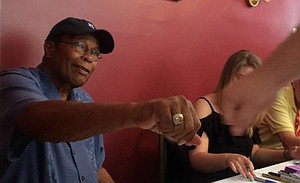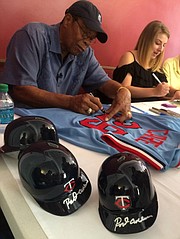8/2/2017

By AMERICAN HEART ASSOCIATION NEWS
COOPERSTOWN, New York – Rod Carew walked down a ramp outside the Baseball Hall of Fame, the final legend leaving the building following a parade and reception. With each step, he heard clapping and the sentiments often sent his way these days.
“Looking good, Rod!” screamed one of the roughly 40 fans still clustered behind a barricade across the street almost three hours after the parade.
“So glad you’re doing well!” shouted another.
Seven months removed from receiving a new heart and kidney, Carew was wrapping up a long day that would’ve worn out anyone. It would’ve been understandable if he’d waved to the crowd, climbed into the waiting SUV and driven off.
Instead, Carew headed across the street. He strolled along the railing, bumping fists, posing for pictures and exchanging small talk.
Over a weekend filled with moments that underscored how far he’s come in his fight against heart disease, this was the most profound. The guy who last year at this time had to be helped in and out of his parade vehicle, who spent the reception parked in a chair and left early because he was so uncomfortable, was now the last to leave – and strong enough to keep the party going.
“You guys are always cheering for me,” he told the fans, “so this is the least I can do.”
Carew entered the Hall of Fame in 1991. He returns most years to welcome the newest inductees into baseball’s most revered fraternity.
Last year’s visit came months after a nearly fatal heart attack and cardiac arrest led to a device being implanted in his chest to keep him alive, a machine called a left ventricular assist device, or LVAD. Simply being here was meaningful.
But it was a struggle. Exhaustion, he thought. The cause turned out to be bleeding in his brain, a setback that jeopardized his quest to get a new heart – or worse.
When he got the transplant in December, Carew knew he couldn’t travel for at least six months.
Luckily, Hall of Fame weekend was seven months away.
Carew has been pushing himself in rehab for two hours three days a week. Since his six-month checkup, he’s already flown to Minneapolis to be honored at a Twins game and to Miami to be honored at the All-Star Game.
Everywhere he goes, Carew spreads the word about heart health. That’s the mission of Heart of 29, the campaign with the American Heart Association that he and his wife, Rhonda, launched shortly after his ordeal began in September 2015.
The campaign took its name from the jersey number Carew wore throughout his career. It now has added meaning: His organ donor, Konrad Reuland, was 29 when he died following a ruptured brain aneurysm.
Reuland was an NFL player, making their heart the first shared by pro athletes. Even more amazing is that donor and recipient had met; Reuland went to the same middle school as Carew’s children and their paths crossed at least once when Reuland was 11.
The compelling ties that bind this story continue generating attention, widening the reach of Heart of 29. A news conference Saturday morning provided another opportunity.
“Konrad Reuland is here with me today at the Hall of Fame,” Carew said. “Konrad travels with me now because we’re trying to save lives. … We’re going to do a lot of good work together.”
Carew held a news conference in the same room last year, too. Then, he showed the controller and batteries powering his LVAD. This year, he showed the actual mechanism that used to be inside him.
“This is, to me, almost like a miracle,” he said. “I feel great. My heart’s roaring. … It was a long journey, but it was a good journey.”
Carew’s next stop was an autograph signing just off Main Street, across from the Hall.
Signs posted on the walls set out Carew-specific ground rules: No handshakes. No photos behind the table. It’s a reminder that infection is a constant fear, that as great as he’s doing, trouble can still be lurking.
Carew was scheduled to sign for one and a half hours. Demand – and his newfound stamina – pushed him beyond two hours before he asked to cut it off. Of the roughly 30 baseball greats here this afternoon, none lasted as long and had as many customers.“Wow,” Carew said as Gray flipped through the pages.
On a blank page, Carew wrote, “May God continue to give you his blessings.” He handed the book back to Gray and said, “I want to show you something.”
Out came his LVAD again.
“Imagine this being inside of us,” Carew said.
“That’s what I had, too,” Gray said.
“Did you feel it?” Carew said.
“I could feel it on my ribs right here,” Gray said, touching the bottom left of his rib cage.
“I didn’t,” Carew said.
There they were, two medical marvels swapping stories. Just like Carew shares a special bond with his fellow Hall of Famers, he feels another type of connection with Gray, a 39-year employee of Owens Corning who loves canning and volunteering at the hospital where his life was saved.
“Great seeing you,” Carew said, reaching out to bump fists.
After a few more people file through the line, a young man wearing a Montreal Expos hat backward handed Carew a ball to sign.
“How’s your health, sir?” the fan said.
“It’s good,” Carew said, looking down at the ball.
“I’m a transplant patient myself, sir,” the fan said. Carew’s head snapped up.
“Are you?!” Carew said.
“Yeah, kidney,” the fan said. “Not as bad as you, but still.”
“I had a kidney, too,” Carew said.
“Yeah, how are you feeling?” the fan said.
“I’m feeling good,” Carew said.
“It’s great – a second chance at life,” the fan said.
Hall of Famer Barry Larkin was signing autographs at a nearby table. One of his friends met Carew soon after.
“Mr. Carew, you are an inspiration,” the man said, pulling down at the neck of his shirt to reveal his heart-surgery scar.
Carew leaned in to look, then unbuttoned his shirt to reveal his scar. He flashed a warm smile and offered another fist bump.
“We’re brothers, you know,” Carew said.
“Yes,” the man said, leaning back and offering a thumb’s up gesture. “Yes, we are.”
Dave Gray and his son, Matt, have made the hour-plus trek from East Greenbush, New York, many times. Primarily Yankees fans, their sole purpose this year was seeing Carew.
Gray is recovering from his own stint with an LVAD and heart transplant. The LVAD enabled him to walk his daughter down the aisle. His second grandchild arrived a few months after he received his new heart. The transplant was 11 months ago, and he still wears a surgical mask in crowds as added protection from infection.
Gray created a photo book commemorating his journey. He uses it to encourage other patients on the waiting list. He thought having Carew’s signature would enhance his message.
Last year, the parade provided the emotional crescendo of Carew’s weekend. Someone yelled, “Thanks for being alive,” and Carew didn’t leak tears, as he often did during his LVAD days, he went into a shoulder-shaking bawl.
This time, lines like “Keep living!” kept Carew smiling. The exception was seeing a group of fans place their hands over their hearts. That turned his eyes watery.
Another memorable moment last year was the Sunday induction ceremony. It was Carew’s public low point as he had to be helped on and off the stage, and struggled even with the assistance.
This time, Carew was introduced with his usual baseball accolades, capped by emcee Brian Kenny of MLB Network saying, “This year, the visit to Cooperstown is all the more special as in just the past few months, he had both a heart transplant and a kidney transplant, and his life has been saved. It is especially wonderful to welcome back this year, Hall of Fame Class of 1991, ladies and gentlemen, Rod Carew.”
And out he walked, waving and striding to his spot, the roar of the crowd growing with each step.
For the Hall of Famers, their highlight of the weekend is a private dinner on Sunday night – men in their 40s through 80s catching up and cutting up like teenagers.
Carew went into last year’s dinner wondering if he’d ever make it back.
This time, he held a show-and-tell session. With his LVAD, of course.
The raucous room became silent. Baseball’s best turned to attentive students as Carew explained what the device did for him and where it had sat inside his body.
He passed it around so others could take a good look and feel the weight – about as heavy as two baseballs. They were awed by what it did and stunned to hear that he never felt it.
Carew closed with his call to action.
He asked who’s gotten their heart checked? Who’s made sure their family has done it? Their friends?
Then he tapped his heart and said, “My boy is right here with me,” and asked who’s an organ donor?
“It was all well-received, too,” Carew said the next day. “Our message is getting through. And that’s all we want to do.”


